Icon with the “Dormition of the Virgin” (Koimesis) and Tryptic with “Deesis”
Artist: Sacred Russian Art
Date: Various
Classification: Painting
Dimensions: Various
Materials: Tempera on panel with riza and metal elements
Adopted By: The New York Chapter
Description
MEDIUM PRIORITY PROJECT
TOTAL COST: € 31.867,84 ($ 34,053.97)
Artist: Sacred Russian Art
Date: 15th-16th century
Dimensions: 33,5 cm x 27 cm
Materials: Tempera on panel with riza and metal elements
Inventory Number: 40538
The ancient Vatican icon depicts the Dormition of the Virgin (in Greek Koimesis) in the center, with the Mother of God on her deathbed, surrounded by the array of emotionally moved apostles and other figures (yet to be identified). Peter and Paul are easy to recognize and are in the front row. In the background, Jesus appears in a mandorla with the crossed nimbus on his head, thoughtfully holding a small figure, representing the Virgin’s soul. The work, created by an anonymous Russian painter between the 15th and 16th century, needs restoration. The study will make it possible to unravel the enigmas of the iconography, specify the dating and provenance, and, with careful analysis, decipher for the first time the inscriptions in Church-Slavic on the metal cover, which celebrates the painted sacred narrative.
State of Preservation
On the back, there is sparse coverage along the perimeter of the painted surface because of the metal elements and haloes on the internal figures. The varnish appears very dulled or is perhaps absent. Also, there were observations of cracks, micro slumping, gaps and previous retouching. Additionally, there are holes for anchoring the missing haloes. Laterally, on the long sides, there are observations of a red finish with probable decorations in white. The support, also partially visible, has two original sliding crosspieces, and they are in need of functional revision.
- Disassembly/remounting riza and metal elements
- Insertion of expanded polypropylene protections where necessary
- Anoxic treatment
- Possible protective glazing prior to restoration of substrate and functional review of crossbeams
- Cleaning for removal of oxidized paint and altered touch-ups.
- Consolidation micro lifting, plastering, and reintegration of gaps in the paint film
- A protective varnishing will be the final step
Artist: Sacred Russian Art
Date: 16th-17th century
Dimensions: 34 x 12,5 cm
Materials: Tempera on wood with riza and metal elements
Inventory Number: 40998
The precious travel triptych dates between the 16th and 17th centuries. It depicts the famous iconographic theme of Byzantine origin called “Deesis,” which translates as “supplication,” “prayer,” and “intercession.” In the center is the enthroned Christ blessing with his right hand and holding a scroll with his left. On the sides are Our Lady and St. John the Baptist, encountering Christ Pantocrator who is praying on behalf of humanity. Painted on the right side is the icon of the so-called “Smolensk” Madonna; St. John the Evangelist and the Angel are on the left. This ancient Russian goldsmith’s artifact has critical conservation issues on the delicate painted surface and the fine metal cover. The study, accompanied by the restoration, will allow the in-depth investigation of the art-historical aspect that makes this type of triptych so important.
State of Preservation
It is possible to only view the work partially because of its placement in the display case. On the back, there is sparse coverage along the perimeter of the painted surface because of the metal elements and haloes on the internal figures. The varnish appears highly opaque, in some areas very yellow with cracks, probably due to a drying agent. Cracks, microlifts, gaps, altered retouches, and small holes are present. The mount, which is also partially visible, has a small fixed crossbar on the back of each individual compartment that is in need of functional revision.
- Disassembly/remounting of the riza and metal elements
- Insertion of expanded polypropylene protections where necessary
- Anoxic treatment
- Possible protective glazing prior to restoration of substrate and functional review of crossbeams.
- Cleaning for removal of oxidized paint and altered touch-ups
- Consolidation of the micro-lifting, plastering and reintegration of gaps in the paint film
- A protective varnishing will be the final step Total
Detail
Inventory N°: 40538, 40998
Artist: Sacred Russian Art
Date: Various
Dimensions: Various
Materials: Tempera on panel with riza and metal elements
Department:
Byzantine - Medieval ArtLaboratories:
Painting & WoodWishbook year: 2024
Icon with the “Dormition of the Virgin” (Koimesis) and Tryptic with “Deesis” - Second Restoration Update
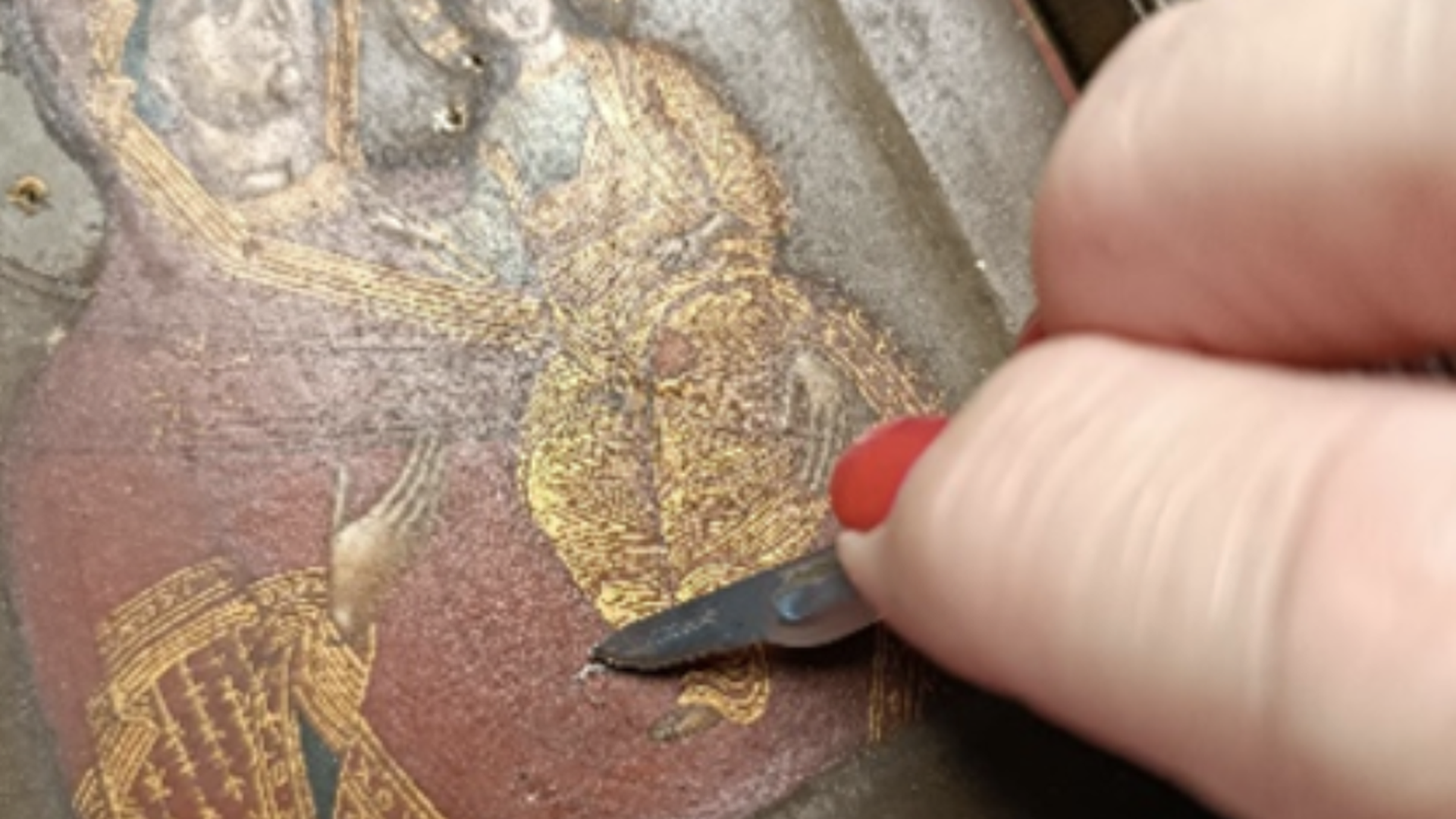
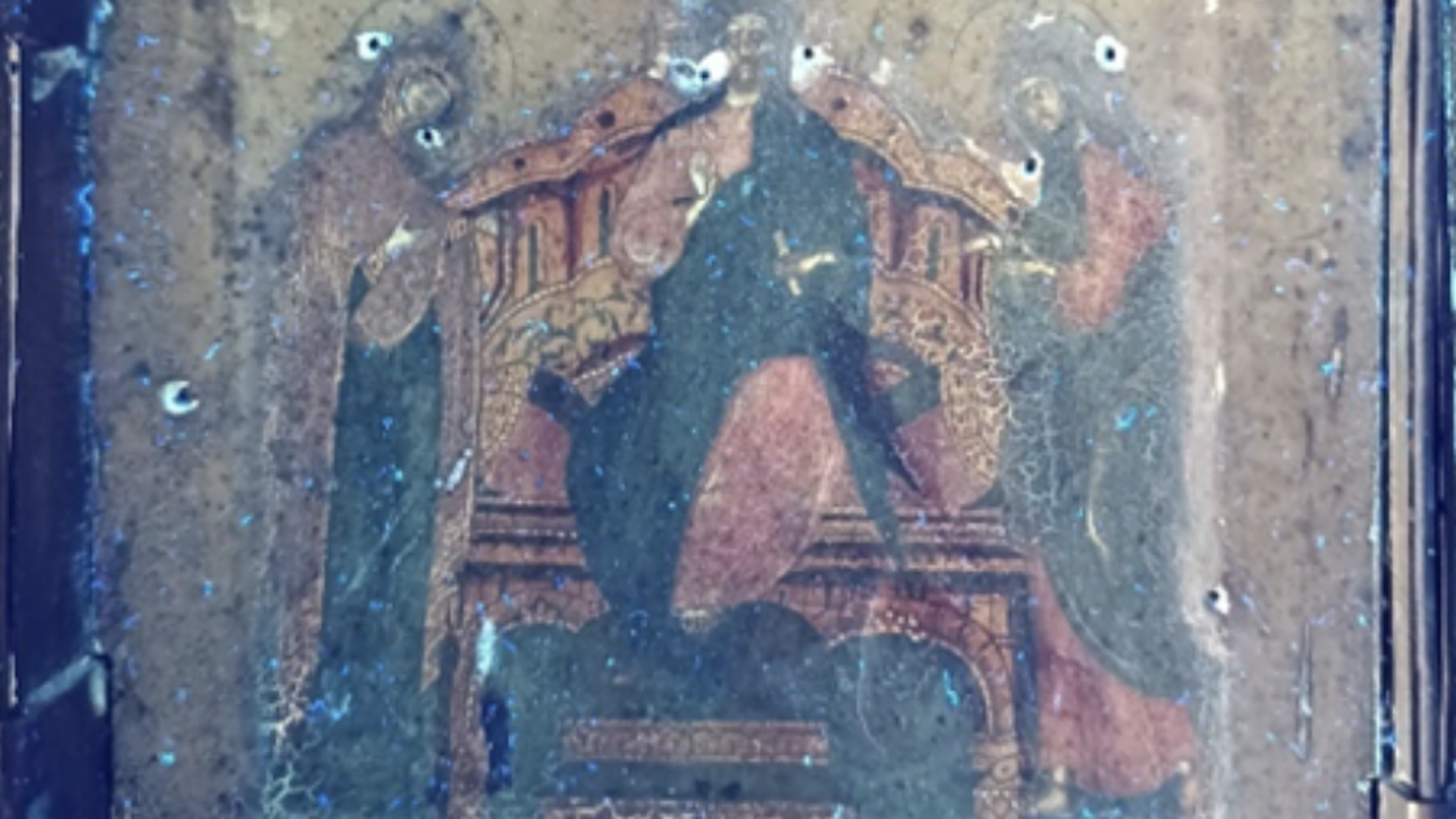
Icon with the “Dormition of the Virgin” (Koimesis)
State of Preservation
Before the restoration, the icons, painted in tempera on panels, showed an altered varnish over a large part of the painted surface, with evident unevenness affecting the color relationship. In dismantling the metal halos, the restorers noted the presence of many more holes than were necessary to secure them.
Restoration Procedures
The intervention began with scientific protocol studies, after which all the fixings and consolidations of the paint film were carried out. Restorers performed cleaning tests to determine the most appropriate method. Once the cleaning phase was completed, the micro-gaps and previous holes were filled, excluding those used to fix the metal haloes. The wooden support was restored, the channels of the old crossbeams were reworked, and two new ones were made, which were initially inserted flush with the support. The part of the crosspiece recovered from the original was fitted. A restorer from the ceramics and metals laboratory is now cleaning the metal parts of the 'riza'. For the time being, only the micro-casting of the unused holes has been chromatically reintegrated. The reintegration will be completed as soon as the cleaning of the 'riza' is finished.
Tryptic with “Deesis”
State of Preservation
Painted in tempera on a pine panel, the work presents a pictorial surface whose chromatic relationships are flattened by a very dark varnish. Each compartment of the triptych is inserted in a metal frame that cannot be removed and is covered in the background by carved metal sheets and halos that mark the figurative part.
Restoration Procedures
The Scientific Research Laboratory performed preliminary scientific studies, examining the painting technique and the state of preservation through a digital microscope. Then, a restorer from the Metal and Ceramic Laboratory removed the metal halos.
All consolidations of the paint film were carried out. The first step in the cleaning process was to mechanically remove the large, uneven, deposits and wax droplets. The scientific analysis of the deformation in the lower part of the throne, on the right, has been completed. Restorers are now cleaning and filling the gaps and then will start the reintegration and painting.
Icon with the “Dormition of the Virgin” (Koimesis) and Tryptic with “Deesis” - Restoration Update
Restoration Procedures
The intervention began with scientific protocol studies on both icons, and then the restorer fixed and consolidated the pictorial film. The restorer proceeded with cleaning tests to determine the most appropriate method, and once the cleaning phase was complete, she filled all the micro-gaps and previous holes. The restoration of the wooden support included: the revision of the channels of the old crossbars the creation of two new crossbars, initially inserted flush with the support. Next, the application of the portion of the crossbeam, that was recovered from the original. Soon, the restorer will begin to restore the color of the gaps, the final painting, with graphic and photographic documentation.

Icon with the “Dormition of the Virgin” (Koimesis) and Tryptic with “Deesis”
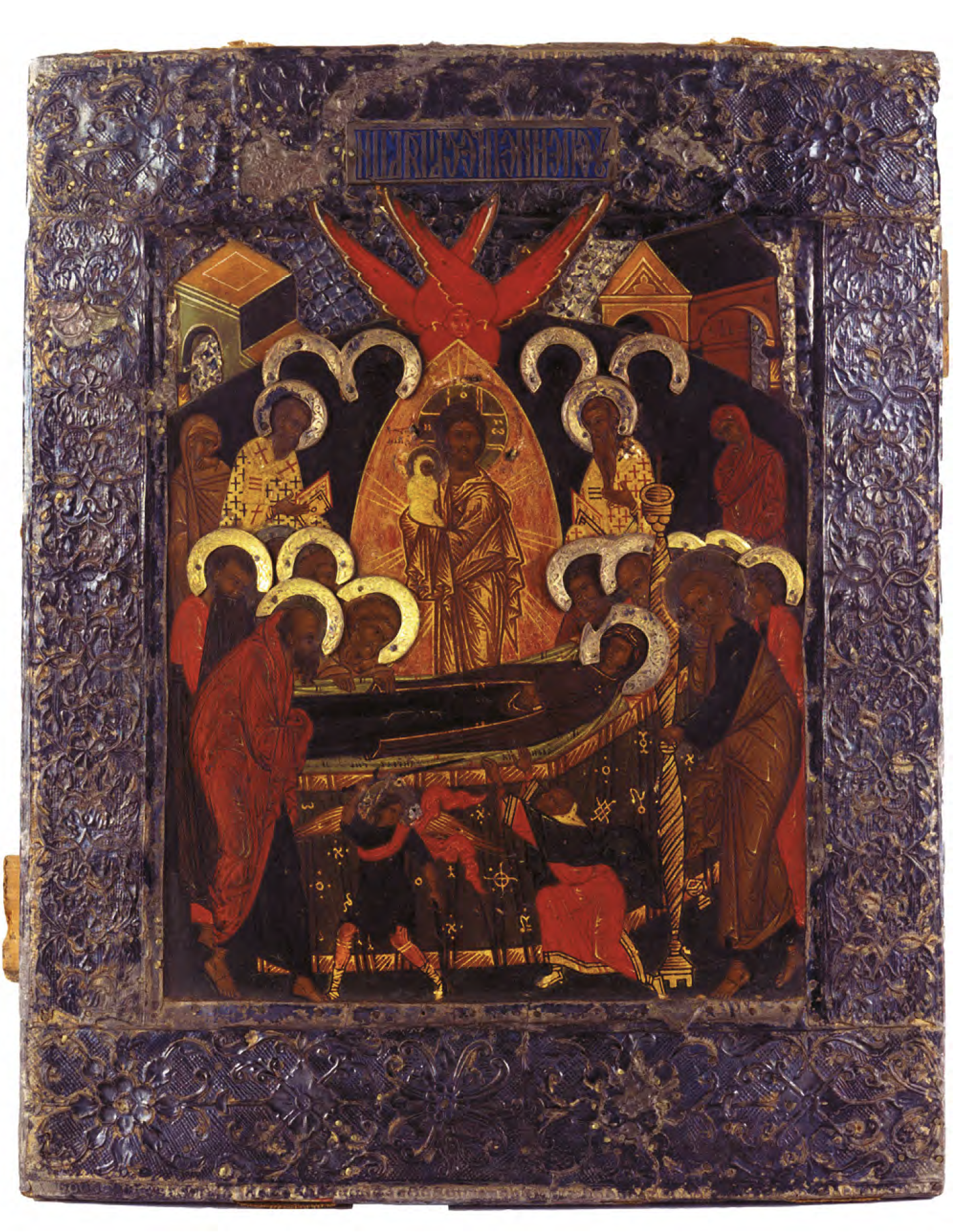
Details
Adopted by: The New York Chapter
Patrons: Camillo J. & Florence B. D'Urso Foundation
Inventory: 40538, 40998
Artist: Sacred Russian Art
Date: Various
Classification: Painting
Materials: Tempera on panel with riza and metal elements
Dimensions: Various
Department: Byzantine - Medieval Art
Laboratory: Painting & Wood
Wishbook year: 2024
Description
MEDIUM PRIORITY PROJECT
TOTAL COST: € 31.867,84 ($ 34,053.97)
Artist: Sacred Russian Art
Date: 15th-16th century
Dimensions: 33,5 cm x 27 cm
Materials: Tempera on panel with riza and metal elements
Inventory Number: 40538
The ancient Vatican icon depicts the Dormition of the Virgin (in Greek Koimesis) in the center, with the Mother of God on her deathbed, surrounded by the array of emotionally moved apostles and other figures (yet to be identified). Peter and Paul are easy to recognize and are in the front row. In the background, Jesus appears in a mandorla with the crossed nimbus on his head, thoughtfully holding a small figure, representing the Virgin’s soul. The work, created by an anonymous Russian painter between the 15th and 16th century, needs restoration. The study will make it possible to unravel the enigmas of the iconography, specify the dating and provenance, and, with careful analysis, decipher for the first time the inscriptions in Church-Slavic on the metal cover, which celebrates the painted sacred narrative.
State of Preservation
On the back, there is sparse coverage along the perimeter of the painted surface because of the metal elements and haloes on the internal figures. The varnish appears very dulled or is perhaps absent. Also, there were observations of cracks, micro slumping, gaps and previous retouching. Additionally, there are holes for anchoring the missing haloes. Laterally, on the long sides, there are observations of a red finish with probable decorations in white. The support, also partially visible, has two original sliding crosspieces, and they are in need of functional revision.
- Disassembly/remounting riza and metal elements
- Insertion of expanded polypropylene protections where necessary
- Anoxic treatment
- Possible protective glazing prior to restoration of substrate and functional review of crossbeams
- Cleaning for removal of oxidized paint and altered touch-ups.
- Consolidation micro lifting, plastering, and reintegration of gaps in the paint film
- A protective varnishing will be the final step
Artist: Sacred Russian Art
Date: 16th-17th century
Dimensions: 34 x 12,5 cm
Materials: Tempera on wood with riza and metal elements
Inventory Number: 40998
The precious travel triptych dates between the 16th and 17th centuries. It depicts the famous iconographic theme of Byzantine origin called “Deesis,” which translates as “supplication,” “prayer,” and “intercession.” In the center is the enthroned Christ blessing with his right hand and holding a scroll with his left. On the sides are Our Lady and St. John the Baptist, encountering Christ Pantocrator who is praying on behalf of humanity. Painted on the right side is the icon of the so-called “Smolensk” Madonna; St. John the Evangelist and the Angel are on the left. This ancient Russian goldsmith’s artifact has critical conservation issues on the delicate painted surface and the fine metal cover. The study, accompanied by the restoration, will allow the in-depth investigation of the art-historical aspect that makes this type of triptych so important.
State of Preservation
It is possible to only view the work partially because of its placement in the display case. On the back, there is sparse coverage along the perimeter of the painted surface because of the metal elements and haloes on the internal figures. The varnish appears highly opaque, in some areas very yellow with cracks, probably due to a drying agent. Cracks, microlifts, gaps, altered retouches, and small holes are present. The mount, which is also partially visible, has a small fixed crossbar on the back of each individual compartment that is in need of functional revision.
- Disassembly/remounting of the riza and metal elements
- Insertion of expanded polypropylene protections where necessary
- Anoxic treatment
- Possible protective glazing prior to restoration of substrate and functional review of crossbeams.
- Cleaning for removal of oxidized paint and altered touch-ups
- Consolidation of the micro-lifting, plastering and reintegration of gaps in the paint film
- A protective varnishing will be the final step Total
Media

Icon with the “Dormition of the Virgin” (Koimesis) and Tryptic with “Deesis”
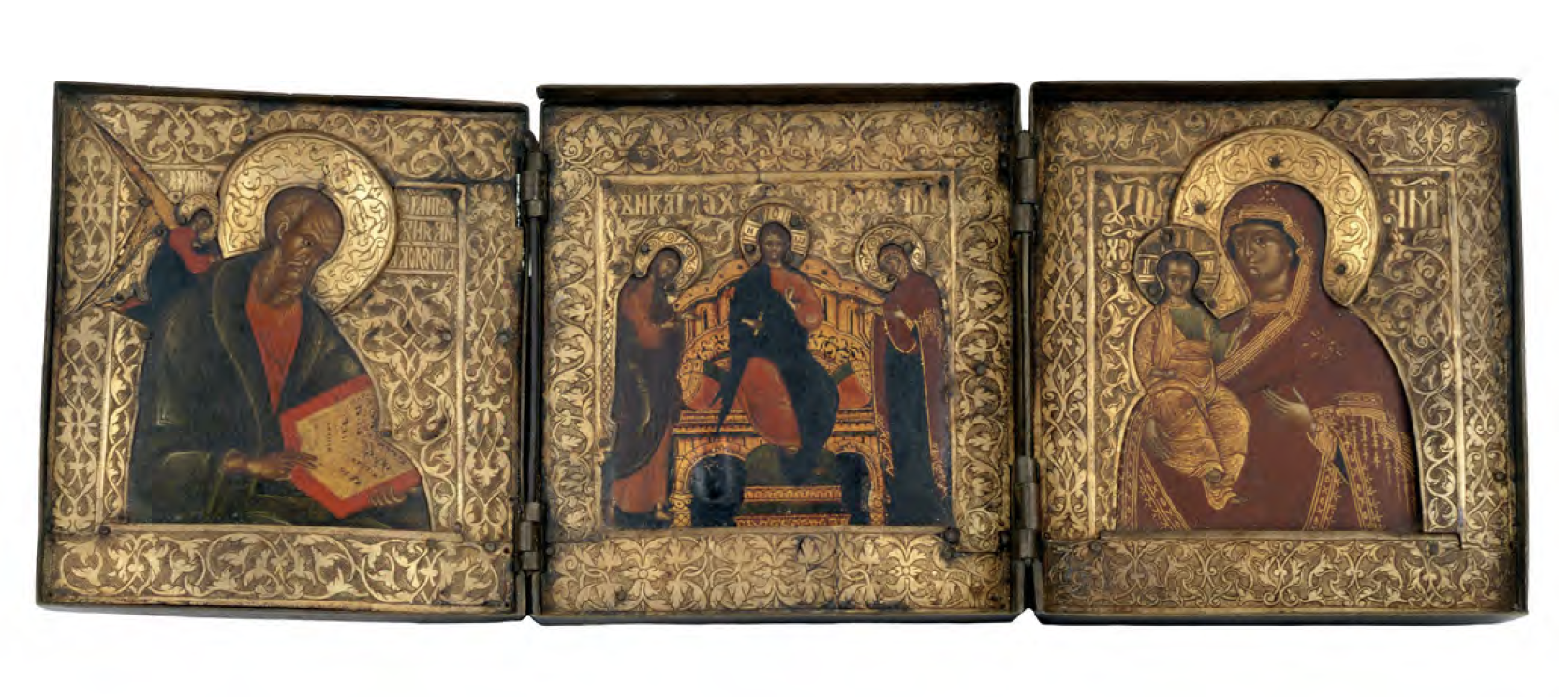
Icon with the “Dormition of the Virgin” 2
Restorations Update: Icon with the “Dormition of the Virgin” (Koimesis) and Tryptic with “Deesis” - Second Restoration Update
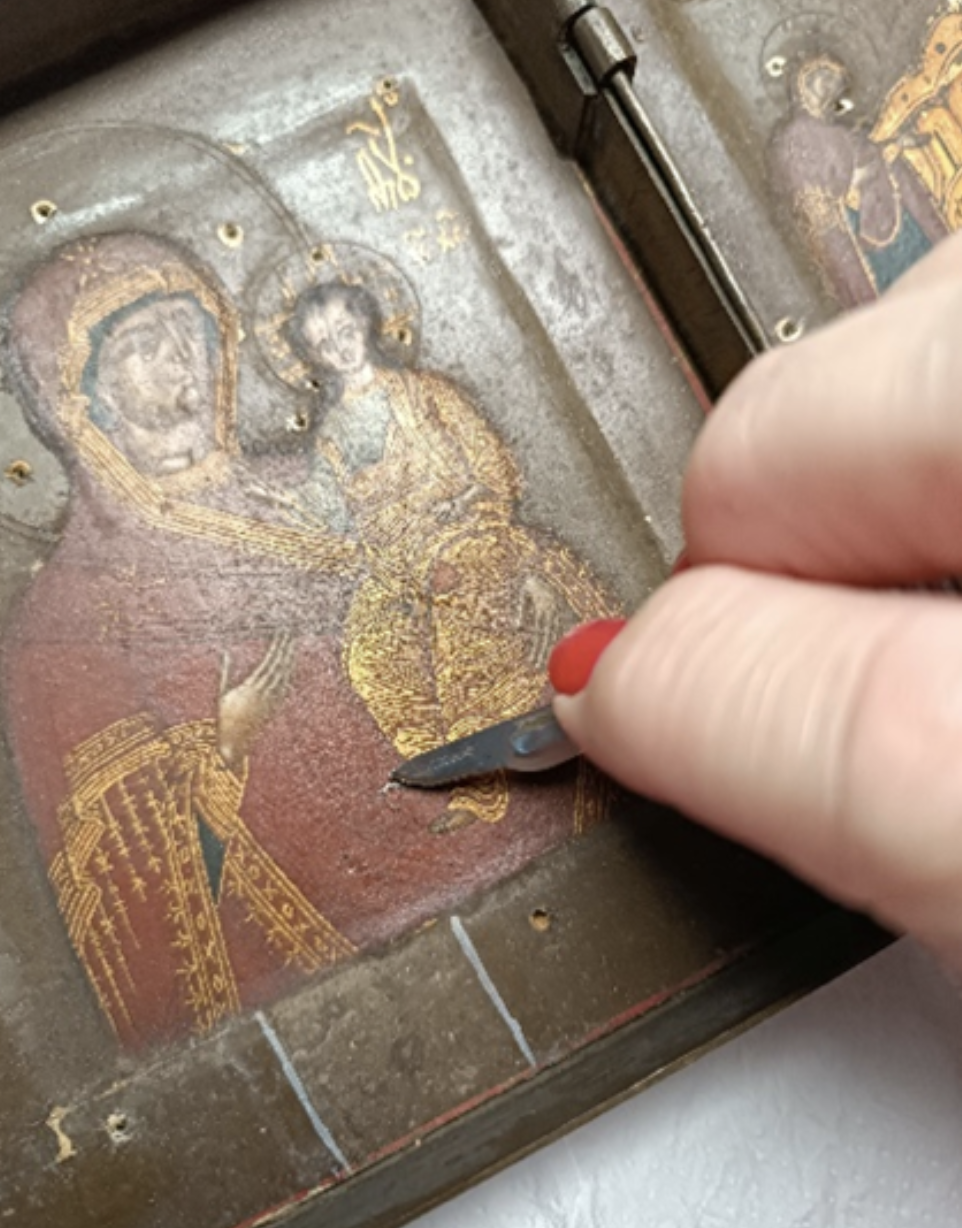
Icon with the “Dormition of the Virgin” (Koimesis)
State of Preservation
Before the restoration, the icons, painted in tempera on panels, showed an altered varnish over a large part of the painted surface, with evident unevenness affecting the color relationship. In dismantling the metal halos, the restorers noted the presence of many more holes than were necessary to secure them.
Restoration Procedures
The intervention began with scientific protocol studies, after which all the fixings and consolidations of the paint film were carried out. Restorers performed cleaning tests to determine the most appropriate method. Once the cleaning phase was completed, the micro-gaps and previous holes were filled, excluding those used to fix the metal haloes. The wooden support was restored, the channels of the old crossbeams were reworked, and two new ones were made, which were initially inserted flush with the support. The part of the crosspiece recovered from the original was fitted. A restorer from the ceramics and metals laboratory is now cleaning the metal parts of the 'riza'. For the time being, only the micro-casting of the unused holes has been chromatically reintegrated. The reintegration will be completed as soon as the cleaning of the 'riza' is finished.
Tryptic with “Deesis”
State of Preservation
Painted in tempera on a pine panel, the work presents a pictorial surface whose chromatic relationships are flattened by a very dark varnish. Each compartment of the triptych is inserted in a metal frame that cannot be removed and is covered in the background by carved metal sheets and halos that mark the figurative part.
Restoration Procedures
The Scientific Research Laboratory performed preliminary scientific studies, examining the painting technique and the state of preservation through a digital microscope. Then, a restorer from the Metal and Ceramic Laboratory removed the metal halos.
All consolidations of the paint film were carried out. The first step in the cleaning process was to mechanically remove the large, uneven, deposits and wax droplets. The scientific analysis of the deformation in the lower part of the throne, on the right, has been completed. Restorers are now cleaning and filling the gaps and then will start the reintegration and painting.
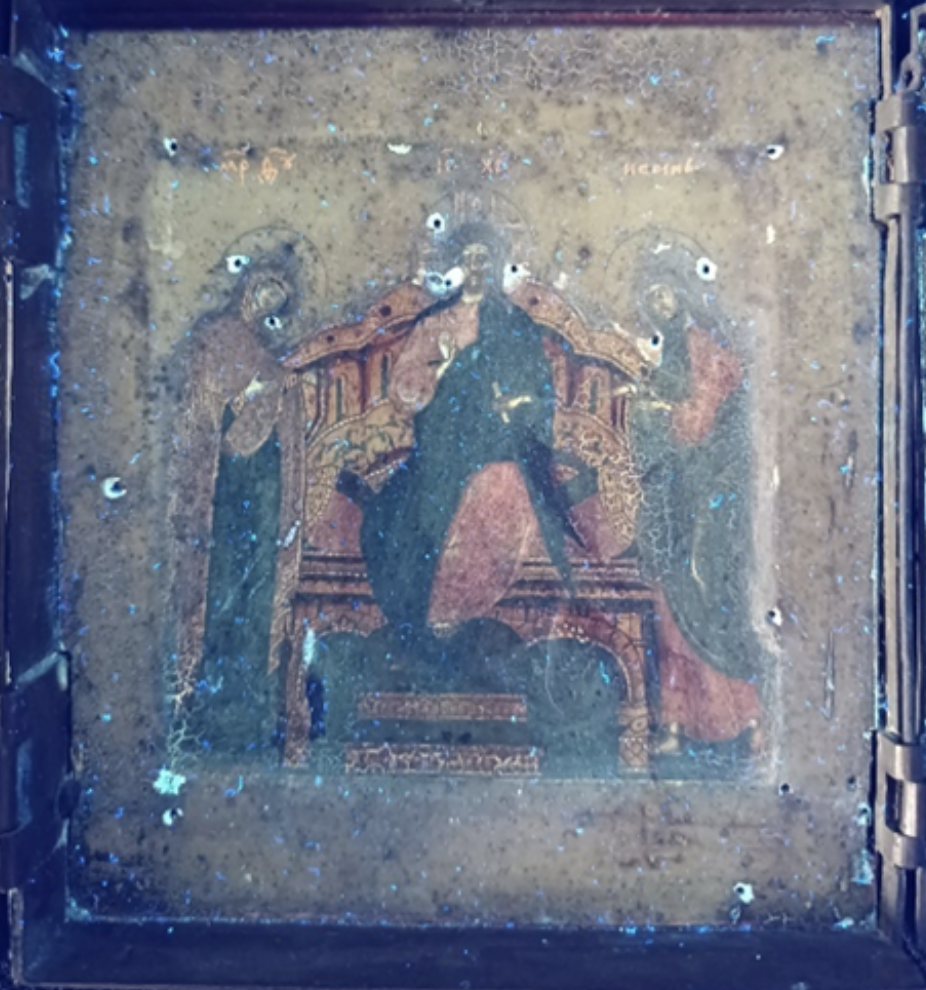
Restorations Update: Icon with the “Dormition of the Virgin” (Koimesis) and Tryptic with “Deesis” - Restoration Update
Restoration Procedures
The intervention began with scientific protocol studies on both icons, and then the restorer fixed and consolidated the pictorial film. The restorer proceeded with cleaning tests to determine the most appropriate method, and once the cleaning phase was complete, she filled all the micro-gaps and previous holes. The restoration of the wooden support included: the revision of the channels of the old crossbars the creation of two new crossbars, initially inserted flush with the support. Next, the application of the portion of the crossbeam, that was recovered from the original. Soon, the restorer will begin to restore the color of the gaps, the final painting, with graphic and photographic documentation.

© 2025 Patrons of the Arts
in the Vatican Museums
Vatican Museums V-00120,
Vatican City State (Europe)
+39 0669864499
